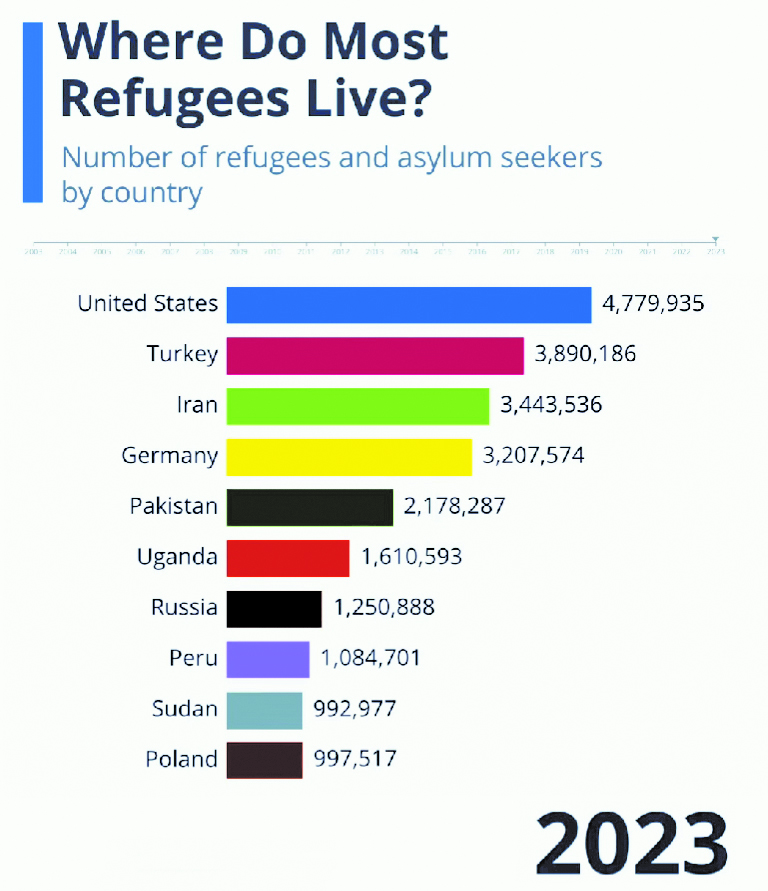
The number of refugees and asylum seekers has witnessed a notable increase in various countries in recent years, as highlighted in the Statista animation utilizing UNHCR data. The majority of these displaced individuals come from Syria, Ukraine, and Afghanistan.
Notably, the United States, Turkey, Iran, and Germany are among the nations currently hosting the largest numbers of refugees and asylum seekers.
As of the conclusion of 2022, the UNHCR reported a global refugee population of approximately 35 million individuals. Concurrently, there are individuals facing internal displacement within their respective countries, compelled to flee and separated from their homes.
The UNHCR’s estimation places the number of internally displaced persons (IDPs) at approximately 62.5 million by the end of 2022. In total, the UNHCR accounted for roughly 108 million people experiencing displacement from their native lands.
Beyond the challenges posed by wars and conflicts, the consequences of climate change further worsen the predicament of displaced individuals. The intersection of conflicts and climate change creates barriers to accessing safety, vital resources, and sustainable livelihoods.
The World Bank’s Groundswell report from 2021 forecasts that if the current trajectory of elevated greenhouse gas emissions and disparate development persists without intervention, an estimated average of 170 million people across six regions will experience internal migration by the year 2050.
These figures are subject to change and hinge significantly on the execution of policies such as achieving carbon neutrality, particularly by the Global North. The countries considered most vulnerable appear to be aligning with the goal of restricting global warming to 1.5°C, as outlined in the Paris Agreement of 2015. However, more developed nations such as Canada, China, Russia, or the United States are anticipated to fall notably short of meeting this target.
STATISTICS BY COUNTRY
Sub-Saharan Africa
As of the conclusion of 2022, the East and Horn of Africa, along with the Great Lakes region, hosted nearly 5 million refugees. This region constitutes 20 per cent of the global refugee population, with approximately 85 per cent residing in Chad (592,800), Cameroon (473,900), and Niger (255,300). A conflict in Sudan, starting in April 2023, led to the displacement of 2.6 million people within Sudan, with an additional 738,000 fleeing to neighbouring countries by July 2023.
Central America and Venezuela
Recent years have witnessed increased violence by organized criminal groups, known as maras, in Honduras, while El Salvador experienced a decrease in organized violence. By the end of 2021, the number of refugees and displaced Venezuelans abroad reached 5.2 million. As of 2022, an estimated 968,300 people from El Salvador, Guatemala, and Honduras were internally displaced or sought asylum in neighbouring countries or countries in the Americas, with an additional 241,900 considered populations of concern.
Europe
By the conclusion of 2022, Europe hosted one-third of the world’s refugees (36 per cent), with the number rising from 7 million at the end of 2021 to 12.4 million at the end of 2022. Turkey remains the largest refugee-hosting country globally, accommodating 3.6 million refugees or 10 per cent of all those displaced across borders. Germany hosted nearly 2.1 million people, constituting 6 per cent of all global refugees. In 2022, over 159,000 people risked their lives attempting to reach Europe, with more than 2,439 reported dead or missing. In response to the vast displacement caused by the war in Ukraine, EU member states and other European nations granted temporary protection to millions of Ukrainian refugees.
Iraq
As of May 2023, nearly 1.2 million Iraqis remain internally displaced, while the country also hosts 273,700 refugees from other nations. Despite the consistent return of around 4.8 million Iraqi internally displaced persons (IDPs) as of May 2023, many still struggle to reintegrate and require ongoing humanitarian assistance.
South Sudan
By the end of 2022, approximately 2.3 million South Sudanese refugees were recorded. As of April 2023, more than 97 per cent of South Sudanese refugees were hosted in Uganda, Sudan, Ethiopia, and Kenya. Outbreaks of violence in 2022 led to 282,000 new internal displacements, increasing the total number of internally displaced persons to 2.26 million as of April 2023. The largest groups of returnees, with 151,300 returning in 2022, were refugees from South Sudan.
Syria
In 2022, the conflict in Syria entered its 12th year, with Syrians accounting for nearly 1 in 5 refugees globally. Approximately 6.5 million Syrians were hosted in 131 countries, and 13.5 million Syrians were internally displaced by late 2022, representing over half of Syria’s total population. Over 75 per cent of refugees (77 per cent) resided in neighbouring countries, including Turkey (3.5 million), Lebanon (814,700), and Jordan (660,900).
Rohingya Refugee Emergency
The Rohingya, a stateless Muslim minority in Myanmar, have faced significant displacement since the start of violence in 2017. Approximately 1.2 million stateless Rohingya refugees have fled Myanmar, with 90 per cent living in Bangladesh and Malaysia.
Ukraine
The ongoing war in Ukraine has resulted in more than 5 million Ukrainians displaced within their country and an additional 6.3 million displaced across borders as of June 2023. Over 17 million people in Ukraine are in urgent need of humanitarian assistance.
Yemen
Fighting in Yemen, one of the poorest countries in the Middle East has compounded needs arising from years of poverty and insecurity. In 2022, the internally displaced population in Yemen reached 4.5 million, with displaced families facing a severe risk of famine. Natural disasters have further exacerbated the conflict in Yemen, leading Yemenis to flee multiple times.
EDUCATION TRENDS
Refugee enrollment remains lower than that of non-refugees across all education levels. As refugee children progress in age, there is an increased risk of them falling behind.
Approximately 48 per cent of all refugee children are still out of school, highlighting a significant gap in access to education.
School closures due to COVID-19 resulted in refugee learners losing an average of 142 days of school up to March 2021. Even before the pandemic, young refugees were already 30 per cent less likely to complete primary school and only half as likely to complete lower-secondary school.
For pre-primary education, enrollment rates for refugees stand at 42 per cent based on data from 40 countries.
At the primary level, UNHCR data indicates that 68 per cent of refugee children are enrolled in school.
However, this enrollment rate drops significantly to 37 per cent for refugee children at the secondary school level.
There is a notable increase in higher education enrollment for refugees, with 6 per cent now enrolled in college or university, compared to 1 per cent in recent years.
Gender Gap: Globally, at the primary level, gross enrollment rates for refugee boys and girls are at 68 per cent and 67 per cent, respectively. At the secondary level, these rates decline to 36 per cent for boys and 34 per cent for girls.















